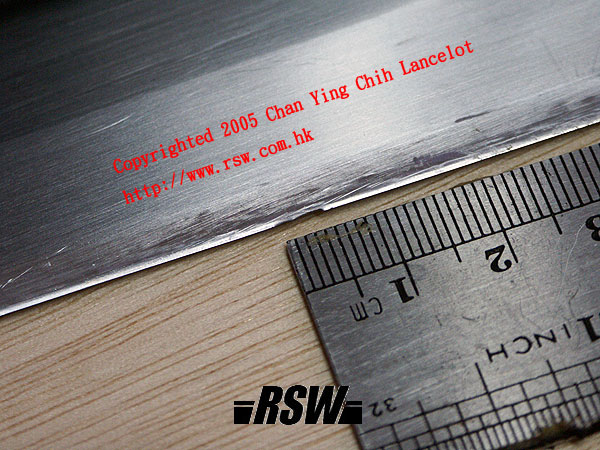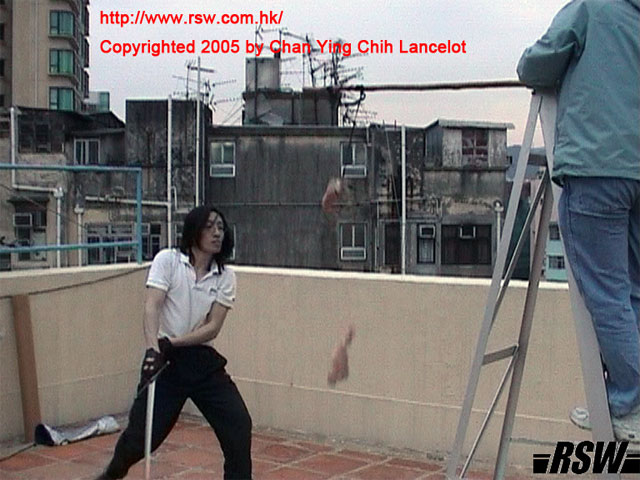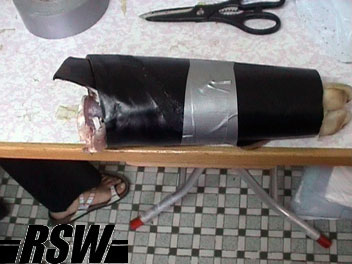

- Freestyle fencing with the historical arsenal
Lancelot's review on his dream sword Brescia Spadona
by Lancelot Chan
Here I share with you an apology email I sent to Albion after a year had passed since I purchased the spadona:
Hello. This email is not asking for your forgiveness but I think I owe all of you a true apology. A year has passed since I purchased the spadona and during the period, I've got to handle more swords from various manufacturers, both eastern and western styles. The truth is that I've now seen a lot more swords with thicker edges than the spadona getting dulled more on the same targets (be it pork, water bottles or whatever). It showed that while the spadona was not among the extreme resilient swords that I handled like the tinker and martial art swords, it was certainly not among the average either. While it is historical accurate, it is also a lot better than the average in its heat treatment, given the very fine edge profile. Plus the non-uniform distal taper, a detail that often missed by other makers, gave it a stiffness and point accuracy not commonly found on sword with this length and light weight. These are all the good things I missed in the year ago until now, when I've seen more swords to compare it with. I know I can't repair the reputation damage I've done to your company and I do not expect a forgiveness from you guys either. I just wanted to let you know that you have now an unsatisfied customer turned very satisfied and feeling owing you guys a lot in the educational course. Please send my words to every crew in your company that was involved in working on my sword, and feel free to post my testimonial. I deserve every backlash for my ignorance. Hope you guys have good business in the future.
In 2002/2003, I exchanged emails with Peter Johnsson, the globally famous European swordsmith. Since I had been wielding my old sword for almost a year, I had learned what I would look for in terms of function and handling feeling in my next purchase. Due to the fact that my old sword was a small and quick bastard sword, it could be a civil dueling sword. It also featured a small but sharp secondary bevel, though. So I hope my next sword would be of the same Oakeshott type XVIIIa, with Peter Johnsson's historical accuracy and sharpness. I also wanted that it would be a slightly larger sword than mine that would suit for battlefield usage, yet without changing my style completely. He told me there was one coming soon and asked me to be patient and stay tuned. I was really patient, yet the fate was against me. My money was spent on getting the master degree, publishing my books and treating my disease against my will. Finally, on February 2005, I bit the bullet and spent the money for the sword even if it means I would have to beg for food on the street the next day! MUHAHAHAHHA...
I waited for 3 weeks without a peaceful sleep and found that the package was held by Hong Kong custom for a routine X ray inspection. Due to the delay, it arrived 2 days later than expected and that did not help my heart of course. Eventually, the white cardboard box showed up on the doorway that housed the wooden crate and the scabbard. The packing was nice and it seemed to me that the horror of damage during transfer did not happened. Thank god!
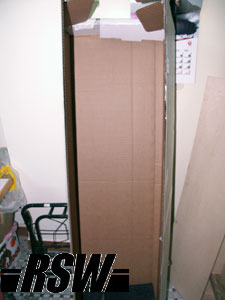
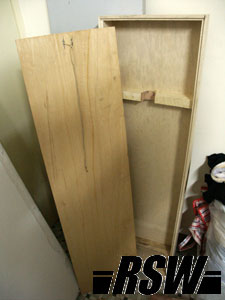
I opened the box and the dream sword was in my sight!
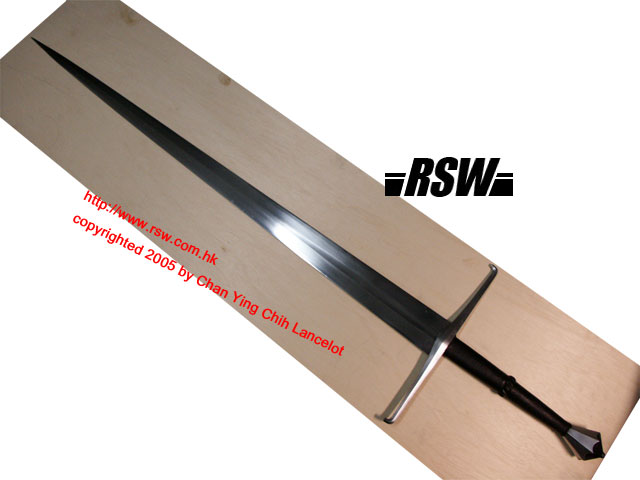
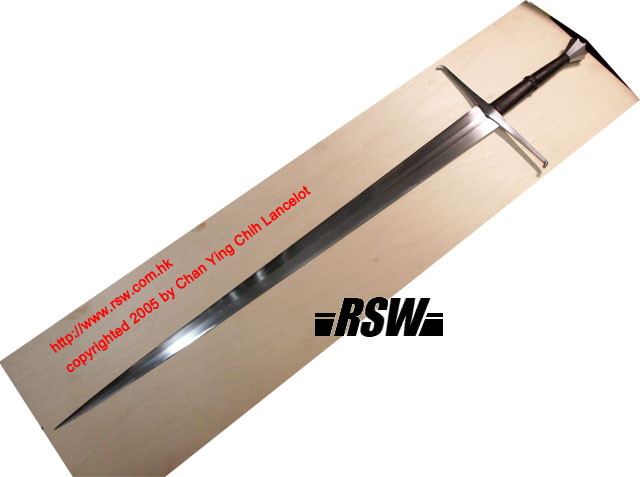
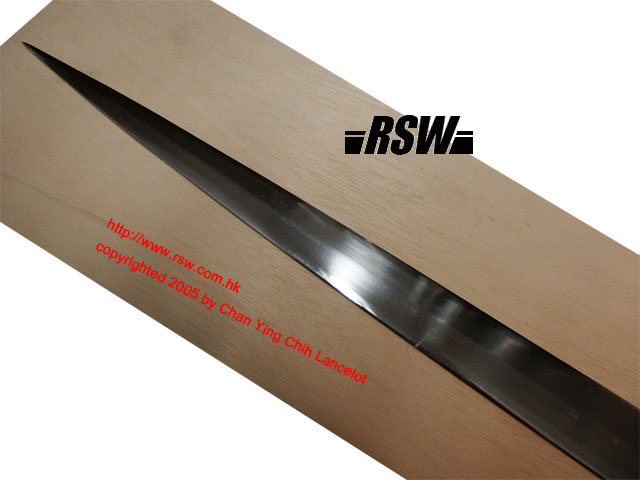
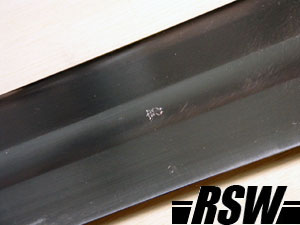 The mark of
Peter Johnsson and Albion.
The mark of
Peter Johnsson and Albion.
Once I took the sword out for a look, it filled me with strong contradiction! First of all, it was heavier than the sword I wielded for years, yet lighter than it would seem to be for such a large size. Another contradiction was that it was both small and big. In terms of length, it was not a very long bastard sword, yet the fittings were all huge. The guard was so wide that it was like the wings of an aircraft and the sword could take off with that. Not to mention that the pommel was a mace that could pierce armor! Moreover, visually the base of the spadona was several times wider than my old one, yet it taper to a slimmer tip than my old one. The whole sword was filled with extremities and there was no modest at all. In terms of gripping feeling, the front hand was great, yet the back hand was irritated by the spiky pommel. I think I have to adjust my grip to get over that (I do not want to wear gloves).
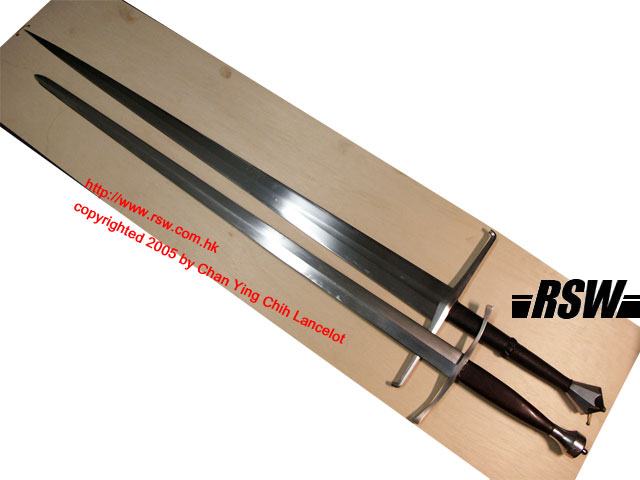
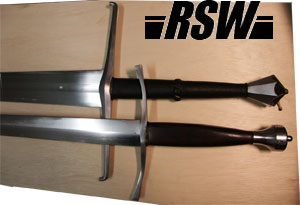
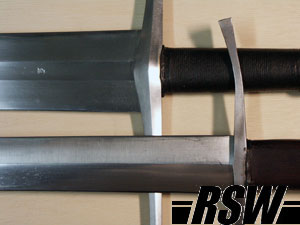
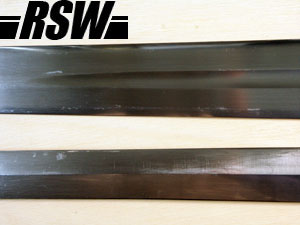
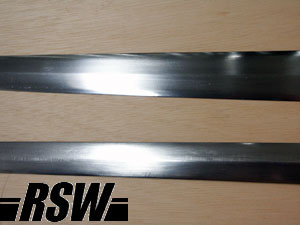
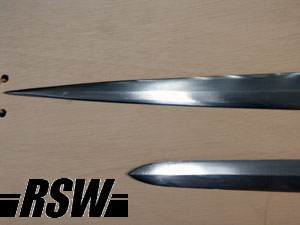
"Why would the fittings be so scratchy? I did not notice that on others' photos and my old sword had a smoother polish than this when it first arrived! Oh my, I just did not want to believe that it was the polish of a 1500 USD sword.", it was one of my first impressions. Later on, it was confirmed by the manufacturer that it was done this way to replicate the hand-made appearance in the medieval Europe.
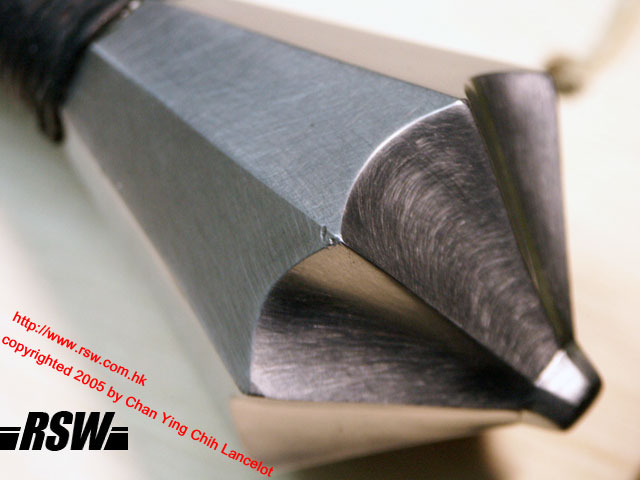
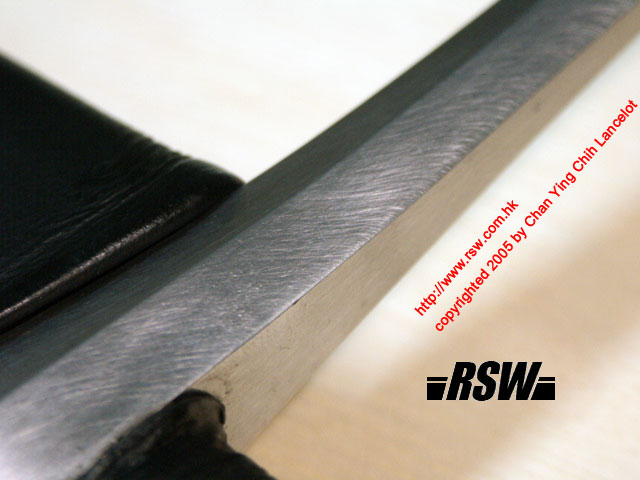
Nevertheless, when I handled the sword a bit longer, I was able to locate the detailed craftmanship on some other spots, such as the wrapping on the grip. The seam of the wrapping was virtually invisible. The scabbard has its own beauty in its simplicity and practicality. Unfortunately, maybe the climate of Hong Kong had enlarged the wooden core, the scabbard was a little bit loose for the sword. The belt was not bad and made the sword suspend at an angle so that the tip would not touch the ground. However, the angle was not my most preferred one and I could not draw the sword quickly. So I would have to perform some modifications.
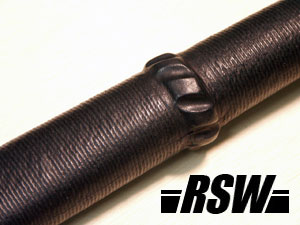
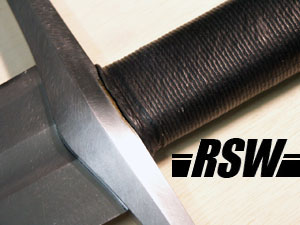
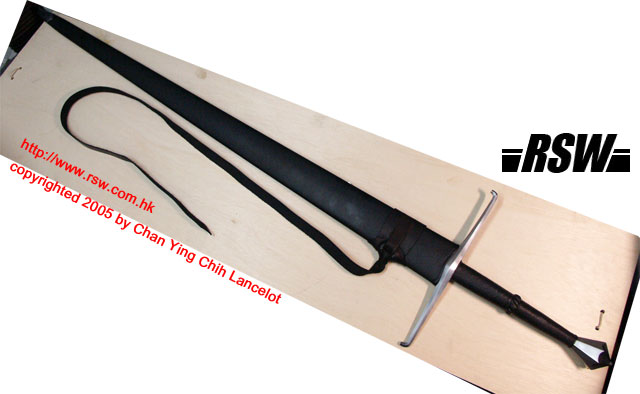
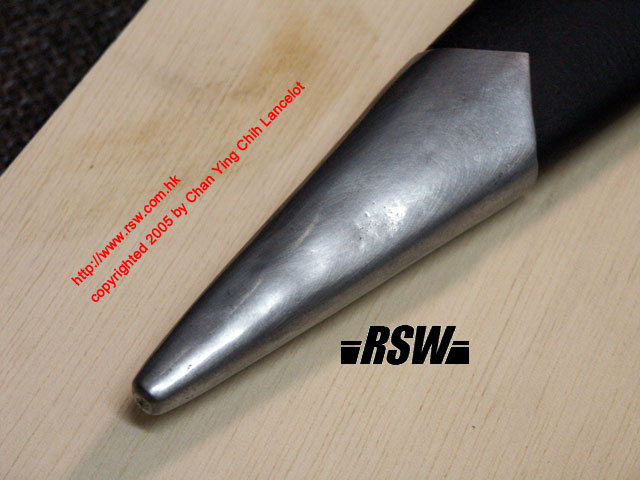
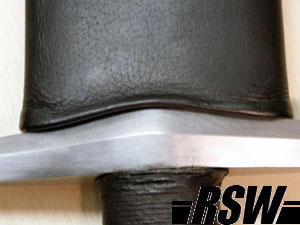
Of course I would not forget to check if my blade was straight or not. After all, I was not totally sure if my new sword had survived the transport without a scratch.
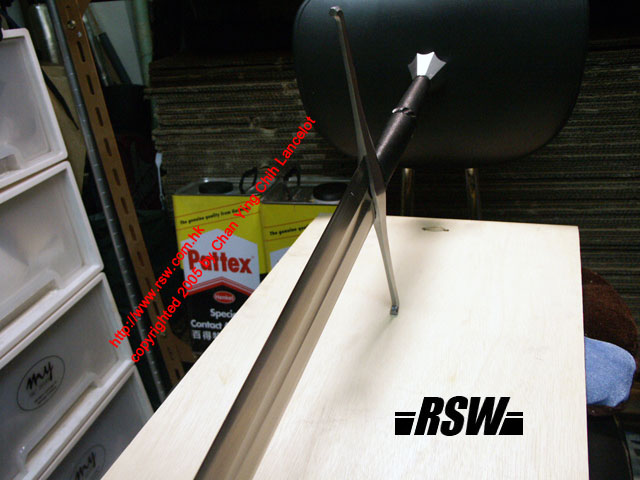
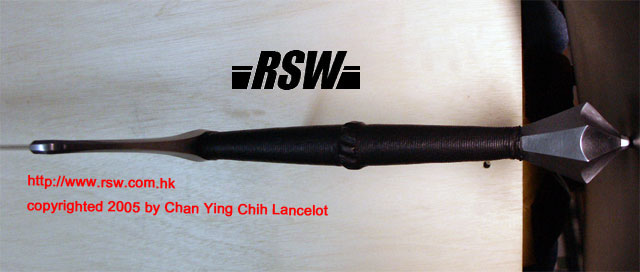
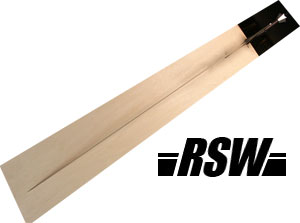 I
discovered that the sword was basically straight with only the very tip
slightly uneven on both flats' thickness. So visually it looked like the tip
was warped to one side. This happened to my old sword as well. I could not
help to entertain myself with the thought that maybe they were from the same
family.
I
discovered that the sword was basically straight with only the very tip
slightly uneven on both flats' thickness. So visually it looked like the tip
was warped to one side. This happened to my old sword as well. I could not
help to entertain myself with the thought that maybe they were from the same
family.
During my examination on the straightness of the sword, I also caught sight of its sharpness. Man, I was so shocked! I had heard about the gradual secondary bevel on this sword, so I did not expect that it was the sharpest sword I had ever seen in my life (including some high end katana)!
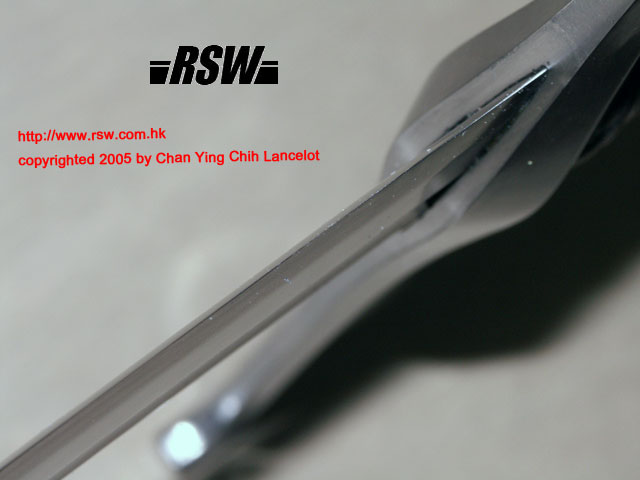
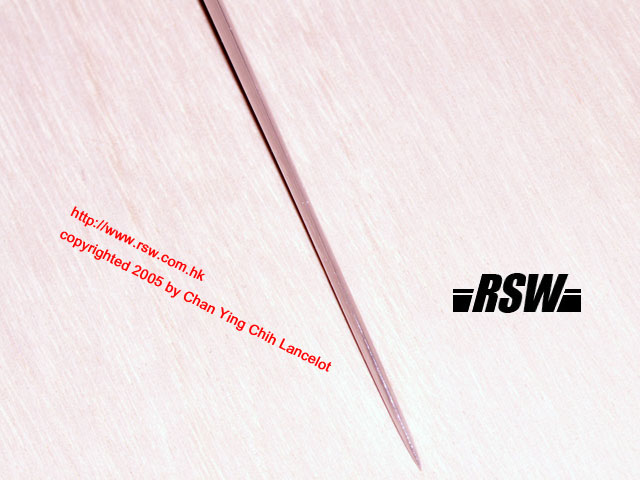
Most of the edge reflected absolutely no light so it was very difficult to take a photo, because it was too sharp! Except the one above that showed some reflections near the tip (only under close proximity with flashlight), the edges were like black hole that could not be seen by eyes. I had never thought that European sword could be this sharp.
Besides, I performed the pivot point test. My old sword was good that the pivot point located within 1 inch distance of the tip. Yet, the new sword was insane that the pivot was right at the very tiny tip of the blade! It means the accuracy for thrusting is supreme!
I visited a Chinese swords show yesterday. Honestly, there was no contender who could compete with the spadona's sharpness! The European characteristic broad and thin blade added with Albion's excellent craftmanship made the blade expressing an exciting feeling that I had never felt! Moreover, it was not overly thin due to the gradual secondary bevel backing up the edge, so that it could sustain the power for cutting bones. Besides, there were no swords at the show that could have such pivot control as Brescia Spadona does.
In my opinion, the two swords I own could be described as women (I used to call my old sword my mistress). My old sword was an oriental beauty who had smooth skin and streamlined physique with the beauty of modest. The new sword was like a western belle that although the skin might not be as silky, quoting my Indonesia friend Leo Song's comment, it has "big boobs, slim waist and super long legs"! The places where it should be big was BIG, where it should be small was SMALL, and it was sharp like no others. Plus the heavenly feeling on the front hand, and the hellish feeling on the back hand, would that be the meaning of a woman having an angel face and devil's body? Overall, it was full of the beauty of extremities.
If you ask me how much it scores so far, I would give it 90 out of 100. (Am I too demanding?)
On 23rd
March, it was deep in the night, 1:30am. I just
finished the 5th drill done with the sword. I have found the perfect gloves
for the sword that featured no leather on the back and on the fingers, yet
thick in the palm. It was perfect for me to retain my gripping power and
blade alignment, yet protected my hands from the mace-like pommel. It gave
all my controls back. Also, the 4 drill sessions I had taken last week had
strengthened me enough to swing this sword around with acceptable speed and
accuracy. So I was itching to see how it would actually cut.
It was not an official test cut report because it was too dark to take
videos. In fact, some friends left 2 water bottles at my place since Sunday
and I also happened to have 2 empty sword boxes. So I set up the boxes
vertically and put the water-filled bottles on top of it, taking a roll of
tissue along with my sword and think: Heck, maybe I can try ... just a bit
of cutting before the official review.
After the setup, I took a deep breath and aim, swing!
"DING!" a very tiny vibration transmitted from the tip of the sword.
The bottle did not move and there was no spilling, in fact I could see
nothing happened.
"Did I just hit the ground with the expensive sword?" I thought to myself,
taking up the blade to examine. There was no water on it, but the tip seemed
to be unscratched and I believe in my skill as well.
Then my friend pointed to the bottle, "Look! The cap is gone!"
We took a closer look, both stared at each other's eyes after learning that
the sword had just gone through the target as if it was a lightsaber! There
was no visible droplets left on the blade. Imagine how sharp it was!
I could not believe that and took aim for a bigger cut. "Ding" again. This
time I saw the upper half of the bottle falling off with water spilled but
the bottom half remained unmoved at all. I did not feel a thing during the
cut and looked at the blade again. There was only very few droplets left on
the blade.
Afterwards, we replaced the target and did it once more. It took the cap off
again.
Then we packed up, cleaned the sword with the tissue and there was no
wetness on it. We tried hard to find the remains in the darkness and here
are the results:
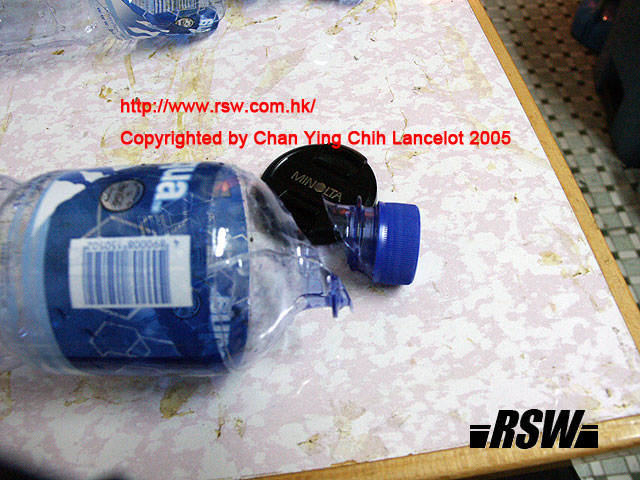
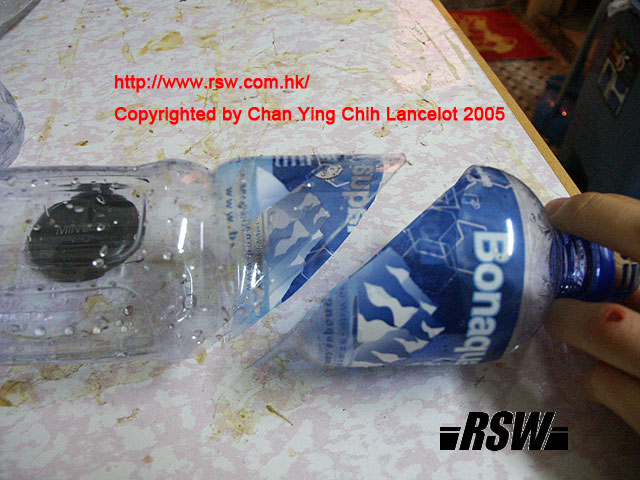
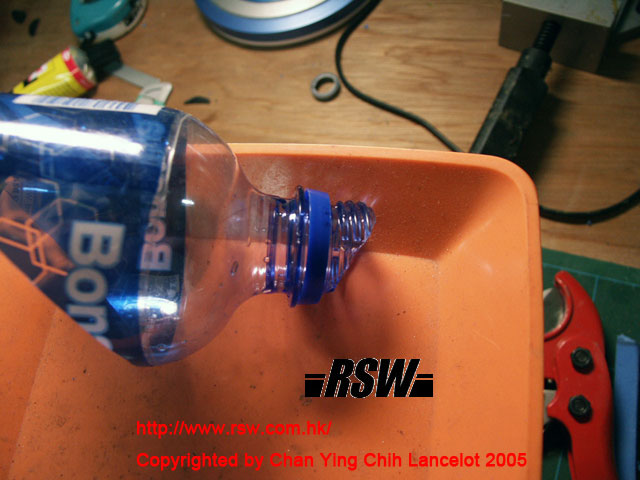
The next day after the bottles cutting, my friend Alfred read the report and grew so excited that he volunteered to buy me pork arms for test cutting. Certainly I agreed and invited Parke to come over to join our event. In this test cutting, I employed the most frequently used technique like downward diagonal, upward false edge cut and single hand leg cutting. We took video recording as follow:
As a conclusion, I am extremely impressed by the sword and would like to give it 120 marks out of 100 by now because of its performance in actual usage!
It has been a while since I last wrote something in this page. Unfortunately my sword went through an accident that when I was adjusting the scabbard, the sword in the vertical cardboard tube was tripped to the ground and crashed pommel wise to the floor.
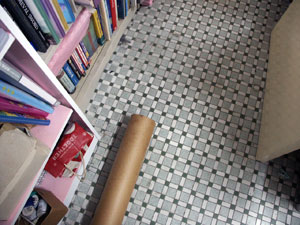
The crash resulted in a significant deformation on 2 of the 8 corners of the pommel and the two ends of the guard. I was surprised by the degree it deformed because if the sword was to be used with pommel strike, the pommel could not deform that easily. Anyway, I sent the sword back to Albion right away without taking photo records. The sword was returned to me as soon as possible after the repair was done and the whole cost was around 300 USD, with only 75 USD the repair cost and the other shipping.
The repair was done by grinding off the deformed material without choices because the hilt was hot peened and it would cost too much labor to unpeen the sword and replace the damaged parts. The lines on the pommel at the area where it was regrinded were less sharp inevitably and the corners that were regrinded lost some volume as a result. However, the regrind work itself was of fine workmanship.
One of the guard's ends was not fully regrinded. I suspected that the deformation there was too bad to reshape the ridge line.
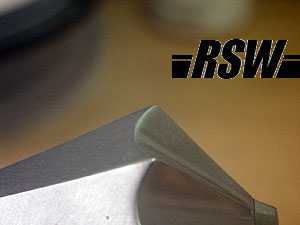
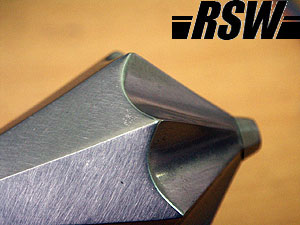
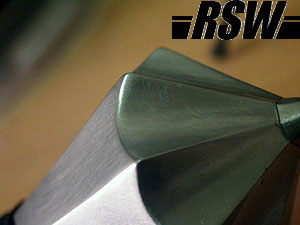
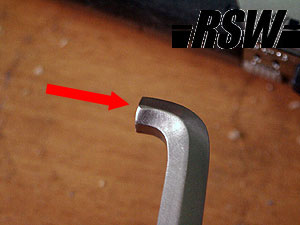
Along the repair service, I had asked for a resharpening / repolishing service on the blade on where I test cut pork arm. The edge there got dulled a bit after the test cut. When I got the sword back, the stains were all gone but the edge was not resharpened. On the other hand, some pommel pittings that came with the sword originally were grinded off during the repair.
I took the sword to test cut again. This time at pork arm wrapped under a piece of 4 mm thick leather piece, unhardened. At some places where there were 2 layers of the leather, it was 8 mm thick.
I performed two handed and one handed cuts and thrusts on the leather, then cutting, thrusting and slicing on the naked pork arm. The result was that the sword was too flexible to puncture the leather reliably with its thrusts. Cutting yielded to penetration on the leather but did not cut the pork arm inside significantly enough to achieve disabling effects. Without leather though, the sword was very lethal. So we can say the sword was an unarmored dueling sword.
By the way, the edge was chewed up during cutting the leather. Maybe the edges were too sharp for their own good? Historically, I think unhardened leather was not outrageous in dueling settings. Plus the guard was dented by either my pants' zipper or the belt's buckle! Again, it showed the fittings were quite soft.
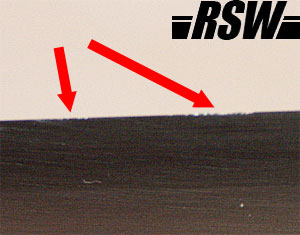
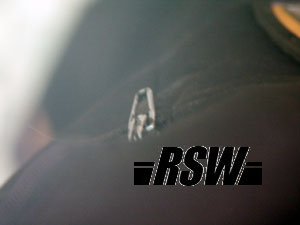
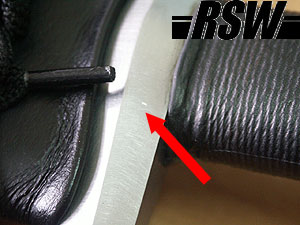
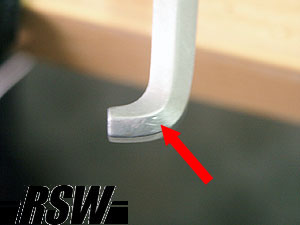
During the photography session above, the sword dropped from the office chair that was 2 feet tall to the floor (damn, again). Luckily, the height was low and the rivet block landed first, thus only 1 ridge on the pommel was dented. I did the repair on the ridge myself to restore it a bit, then I took photo to show the degree of damage it took on the rivet block.
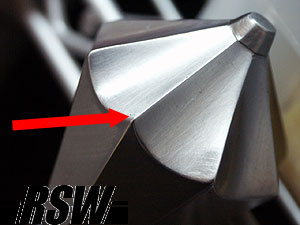
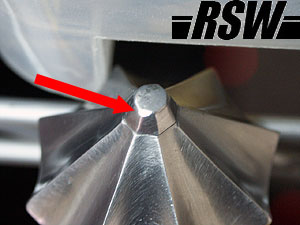
Somehow I feel that this sword is not going to be as long lasting as my previous one.
My guess was correct. In the 3rd pork arm test cutting session, I practiced airborne target test cutting and the edge was damaged once more. The wound was 5mm wide and 0.5 mm deep. The edge was almost damaged every time I test cut on pork arm.
